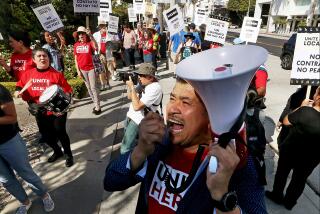Bush Proposes Hikes in Federal Pay of Up to 25%
- Share via
WASHINGTON — President Bush dove back into the politically messy issue of federal pay increases Friday, calling for raises of up to 25% for federal judges and 8,000 of the government’s top executive branch employees along with a ban on members of Congress taking money for personal appearances.
Bush did not propose a congressional pay increase but Press Secretary Marlin Fitzwater said that the President still supports the idea and will work with congressional leaders to develop a politically acceptable proposal.
The whole issue of pay has been a logjam for years. Congress, which must vote on all pay raises for federal employees, has strongly resisted allowing federal workers to earn more than congressmen but has also been reluctant to raise its own pay. A congressional pay raise was defeated in February amid a political firestorm. At the same time, members of Congress are not willing to give up honorariums without a pay increase.
Currently, senators and representatives are allowed to add to their pay by taking money for speeches and other appearances--up to 40% of their salary in the Senate, 30% in the House. Bush’s plan would eliminate that in two stages, becoming fully effective when the next Congress is seated in January, 1991. It is widely expected that any plan to raise the current $89,500 congressional salary would be similarly phased in.
Bush and his aides have been saying that the President would propose a pay increase ever since February, when increases of 51% for members of Congress and federal judges were defeated. Repeatedly, Bush has said that he was waiting for the right time. He chose a moment just before he departs Sunday for a 10-day European trip, which should virtually guarantee that reaction to the pay plan will not dominate the news.
Under Bush’s plan, about 8,000 of the government’s 2.2 million employees would immediately get raises. The increases would range from 25% for the most senior officials down to 8% for more junior executives, taking the salaries for top civil servants over $100,000 for the first time. Vice President Dan Quayle would also get a raise, from his current salary of $115,000 to $143,800. Bush’s own salary would stay at $200,000.
In addition, 200 new positions would be created with authorized salaries of as much as $124,900. Government agencies could use those slots to recruit or retain workers whose special skills are in high demand, such as physicists for the National Aeronautics and Space Administration, doctors for the National Institutes of Health and economists for the Commerce Department.
Given the relatively small number--200 positions to cover the entire government--those slots are expected to be the subject of intensive jockeying among federal agencies. Virtually all federal agencies have been complaining of a rapid drain of highly trained specialists into better paying jobs in the private sector.
In a statement, Bush reiterated support for a 25% pay increase for the nation’s 1,300 federal judges, a plan that he submitted earlier in the spring.
Overall, the plan would add almost $200 million annually to the federal budget. Increasing judicial salaries would cost about $30 million a year. The raises Bush plans for top federal workers would cost about $155 million a year, including $8 million for the 200 new specialists’ jobs. And indirectly, Bush’s plan would cost roughly another $10 million that would go to some 1,100 senior civil servants whose pay is now capped to prevent them from earning more than their bosses. If their supervisors receive a raise, their pay automatically would increase.
The plan came under immediate fire from some federal workers unions, who objected that Bush’s plan would directly or indirectly provide large raises for 9,000 of the government’s highest paid employees while he proposes to hold the vast bulk of federal workers to a 3.6% increase. White House officials defended the proposal, arguing that salaries for most federal workers are roughly comparable to pay in the private sector but that pay at the top levels has fallen seriously behind.
Pay for top federal administrators “has slipped from 66% to 39% of the pay of the lower range of private corporate executives,” Fitzwater said, “key scientific, medical and economic jobs remain unfilled in our Administration due to non-competitive pay.”
Bush also would require federal officials who receive the increases to undergo reviews every three years to demonstrate that they still deserve the extra pay.
Salaries for senior federal officials have risen relatively slowly. As a result, not only corporate executives, but also local government officials, currently earn more than federal executives, with most school superintendents in large cities, for example, earning more than federal agency directors.
Currently, Cabinet secretaries earn $99,500, their deputies earn $89,500 and salaries for top federal managers below that rank range from $68,700 to $82,500. Under Bush’s plan, Cabinet secretaries would get a raise to $124,000, deputy secretaries would earn $111,900 and the range for top managers would run from $74,500 to $103,100. The wider range of salaries is designed to restore a pay ladder to the senior civil service, where many officials find that long before retirement they have hit the salary ceiling and cannot hope to earn more without leaving government.
Given the concentration of top-level federal officials in Washington, the raises would have their greatest impact here. According to the federal Office of Personnel Management, however, roughly 3% of the federal workers eligible for raises under Bush’s plan are located in California.
More to Read
Get the L.A. Times Politics newsletter
Deeply reported insights into legislation, politics and policy from Sacramento, Washington and beyond. In your inbox twice per week.
You may occasionally receive promotional content from the Los Angeles Times.











